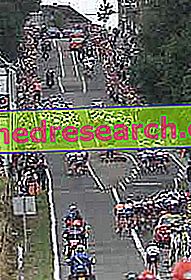AGONISTIC PERIOD
At the beginning of the competitive period it is advisable to participate in tenders that have different technical characteristics. In this way, all the elements that are a prerequisite for a good performance are developed globally.
The maintenance phase of the condition achieved so far consists in slightly reducing the intensity of the training, to increase the duration. For this purpose, the recovery time is increased compared to the standard training of a demanding exit, or the duration and distance of the demanding phases is reduced, or all factors are acted on simultaneously.
Phases of the competitive period:
phase of research and maintenance of the general condition, with average proportion between intensity and quantity of load;
phase of research and maintenance of the form for a well-defined competitive appointment, with very intense loads.
In addition to the aspects concerning specific training, participation in the competitions requires a good knowledge of the main characteristics of the course. It is therefore necessary to memorize perfectly where the difficulties of any kind are distributed: uphill, narrow roads, stretches of pave, rough ground, stretches exposed to the wind, place of refueling, final stretch and any other. Prior knowledge is accompanied by the possibility of being able to cope with various situations with ease, using the most appropriate ratios and tubulars for the route and setting the most appropriate race tactics, particularly during the final stages of the race.
During the race it is advisable to bring a roadmap and an altimetry of the route together with the details of the last Km in a small plastic case. Holding the position in the advanced part of the group (first 20 - 30 positions) allows a better control of the race in every situation, as well as making the risk of falls less relevant.
The climbs are undoubtedly the traits that reveal the difficulties most. In the event that the ratio proves to be inadequate, to change it is advisable that the cyclist does not push down on the pedals, also avoiding to continue on the maximum slope line. The zig-zag gait can be an effective expedient in case the stretch is particularly hard, to avoid "stopping" if the choice of the free wheel has not been happy. However, it is advisable to move to the top positions before the climb begins. If a runner is in difficulty, in the worst case he manages to get off at the center of the group, or in the last positions of the same without getting detached. If instead the same runner has energy to spend he can try an attack. For a runner already tired "to fill a hole" even of just 50 m in this situation becomes a problem that can compromise the final result.
While uphill is the force of gravity the most significant obstacle to advancement, on the plain is air resistance. If keeping even high averages in groups is relatively easy because you are sufficiently protected, once on the run you must instead try to make the most of the advantage of being at the wheel to maintain and increase the advantage. Making a simple row is not the most appropriate technique to maintain the highest speed. In this case the best position to overcome the drag is the parallel double row. This technique allows a remarkable speed, superior to that which would be possible with the simple row for the same effort. Adopting the trick of doing even a second row, one remains in the lead to pull for a very short stretch. The agreement to those who give the change allows, in addition to a good coverage, also to return later from the recovery row in the active row without making a considerable effort as the speed difference is minimal. The choice to make the change to the right or to the left is dictated by the need to protect the recovery line from the wind.

If following a deviation the wind is blowing sideways and the group is compact anchors, the gearbox must be done from the front. The cyclist must increase his pace and move towards the center of the road. In this way he easily finds a place in the fan, because moving backwards forces a runner who is inside the fan to make room for him. By making the change on the other side, he would be forced to return to the end of the line. If you want to split up the group, you move further away from the side of the road where the wind comes from, to allow only a few runners to be protected and start an attack.
Once on the run the change must be given from the side where the wind is coming, then moving towards the side of the road. In this way the runners who are in the fan are better protected. If the rider who has just made the change continues to pedal, he protects his companions from escaping from the wind, then taking advantage of the protection of the rider who was at his wheel when he in turn gives the change. Having reached the height of the last rider, he can resume his wheel seat without particular effort.
With the double fan the riders are not busy at most in the head for a very short period of time. The pace is always high precisely because the effort to lead, for each runner, is of short duration even if of high commitment. If a rider remains in the lead without changing, the pace would decrease, even if at that moment the cyclist thinks he is useful to escape. This effort, carried out in part or mainly with the anaerobic mechanism, would only cause an early fatigue of that runner, compromising his ability to get a good result.
Even the knowledge of the opponents can be of great help for the tactics of the race. Knowing the characteristics, the runner can assess his chances of winning, in relation to his qualities as a sprinter, climber or runner. In case of scarce possibilities, he can decide to attack or counterattack, surprising the opponents, or leaving them all the weight of the escape, until he thinks about the possibility of a strength solution.
On the other hand, the non-fast passist must try to escape either from a long distance, or immediately before the sprint, thus anticipating the sprinters.
Uphill the passist defends himself from the climber going in progression, thus avoiding responding to the shots. The climber, on the other hand, tries to make the most of the terrain that is favorable to him, taking repetitive steps to weaken the opponents who want to insist on holding his wheel. This must not lead him to neglect the control of the race of the previous phase, in order not to see the result compromised by a long-range escape.
Each runner must then assess whether the escape companions allow him well-founded prospects of victory if the commitment of each individual makes one think that the attempt can be successful, if the group lets it do or reacts decisively. Only after these considerations can he decide to lavish all his energies on the success of the attempt, otherwise he collaborates "with reserve" or even remains in the queue for the group.
If there is a sprinter in the breakaway his team looks to control the fastest opponents that are still "in the running". Or launch a component to the attack, while the others remain on the wheels; when you see your opponents in difficulty, you can counterattack and go get your partner on the run, or launch the attack on the break as soon as the flight has been canceled, the opponents are so weakened before the final sprint. In case you are in two against one you can attack by shooting from behind while the opponent is in the lead. If it does not cooperate, the second slows down, allowing the first to break away; if the opponent starts to hang up the first, the second takes the wheel, counterattacking and trying to detach the opponent when he is about to go back under, so as to ensure the result to the team. This tactic is certainly effective in the last kilometers if there is a numerical advantage. The succession of shots and the coverage of the attempts must become almost an automatism, carried out without even needing hints of agreement. The goal is to have at least one member of the team disengage.
The best defense for those who are alone against two when the pinwheel of attacks starts is to assess which of the two opponents is weakest. Responding with decision readiness to the shots of the strongest and pretending instead not to be able to react effectively when the weakest is taking off, therefore putting on his head in rather bland form as if he considered the result of the race to have been compromised, the athlete alone guarantees a period of respite; whoever is at his wheel can only assess with satisfaction that teamwork is working. In this way, whoever is alone maintains sufficient energy to respond to a possible attack by the opponent who remained passive at his wheel. If there are not many kilometers left on arrival, he can even decide to respond by counterattacking when he is about to come back under, he sees the fatigued opponent. If he succeeds in detaching it from the inside, then he must not try to take the first one as soon as possible, because he would remain passive to his wheel to favor the return of the companion, saving at the same time energies in view of the final sprint. He must therefore check mainly not to be filmed and accelerate decisively to recover the fugitive only in the last stages of the race. In such a situation every cyclist is obliged to spend a lot of energy. This translates into an advantage for those who are only able to prevent others from performing team work.
| " Previous one |  | Following " |
Edited by: Lorenzo Boscariol



